Netherlands in World War II
[2] Due to the high variation in the survival rate of Jewish inhabitants among local regions in the Netherlands, scholars have questioned the validity of a single explanation at the national level.Declassified records revealed that the Germans paid a bounty to Dutch police and administration officials to locate and identify Jews, aiding in their capture.[5] The incumbent government of Hendrikus Colijn pursued a programme of extensive cuts to maintain the value of the guilder, which resulted in workers' riots in Amsterdam and a naval mutiny between 1933 and 1934.During the interwar period, the government undertook a significant increase in civil infrastructure projects and land reclamation, including the Zuiderzee Works.[11] Despite its policy of neutrality, the Netherlands were invaded on the morning of 10 May 1940, without a formal declaration of war, by German forces moving simultaneously into Belgium and Luxembourg.[19] The Dutch realised that neither British nor French troops could reach the Netherlands in sufficient numbers to halt the invasion, particularly with the speed of the German advance into Belgium.[19] Fighting in Rotterdam had taken place since the first day of the campaign, when German infantrymen in seaplanes landed on the Maas River and captured several bridges intact.[20] Under pressure from local officials, the garrison commander surrendered the city and his 10,000 men on the evening of the 14th with the permission of Henri Winkelman, the Dutch commander-in-chief.Knowing that the army was running low on supplies and ammunition and receiving news that the city of Utrecht had been given an ultimatum similar to that of Rotterdam,[16] Winkelman held a meeting with other Dutch generals.After the failure of Operation Barbarossa in June 1941 and the subsequent German defeats at Moscow and Stalingrad in the Eastern Front of World War II, Germany increased economic extraction from its occupied territories, including the Netherlands.Some Nazis prepared to make a last stand against the Allied troops, followed Berlin's Nero Decree and destroyed goods and property (destructions of the Amsterdam and Rotterdam ports, inundations), but others tried to mediate the situation.The Netherlands turned into the first line of western air defence for Germany and its industrial heartland of the Ruhrgebiet, complete with extensive flak, sound detection installations and later radar.The Atlantic Wall, a gigantic coastal defence line built by the Germans along the entire European coast from southwestern France to Denmark and Norway, included the coastline of the Netherlands.Over half of the total Jewish population—about 79,000—lived in Amsterdam; this number increased as Germans forcibly moved Dutch Jews into the city in preparation for mass deportation.[31] A 2018 publication, De 102.000 namen, lists the 102,000 known victims of the persecution of Jewish, Sinti, and Roma people from the Netherlands; the book is published by Boom, Amsterdam, under the auspices of the Westerbork Remembrance Center.However, for most higher functions, the Germans preferred to leave the existing elite in place since they knew that the NSB neither offered enough suitable candidates nor enjoyed enough popular support.The Dutch resistance to the Nazi occupation during World War II developed relatively slowly, but its counterintelligence, domestic sabotage, and communications networks provided key support to Allied forces beginning in 1944 and through the liberation of the country.The country's terrain, lack of wilderness and dense population made it difficult to conceal any illicit activities, and it was bordered by German-controlled territory, which offered no escape route except by sea.This was one of the largest resistance groups, numbering around 550 active participants; it was also heavily targeted by Nazi intelligence for destruction due to its links with the United Kingdom.These groups produced forged ration cards and counterfeit money, collected intelligence, published underground newspapers, sabotaged phone lines and railways, prepared maps, and distributed food and goods.The largest Allied invasion of the Pacific Theatre took place in July 1945 with Australian landings on the island of Borneo to seize the strategic oil-fields from the Japanese forces, which were now cut off.In September, the Allies launched Operation Market Garden, a failed attempt to advance from the Dutch-Belgian border across the rivers Meuse, Waal and Rhine into the north of the Netherlands and Germany.The crushing need for a large supply port forced the Battle of the Scheldt in which First Canadian Army fought on both sides of the estuary during the month to clear the waterways.Strong German defences made a landing very difficult, and the Allies responded by bombing the dikes of Walcheren at Westkapelle, Vlissingen and Veere to flood the island.Bergen Op Zoom was taken by the Canadians and the Polish 1st Armoured Division led by General Maczek liberated the city of Breda without any civilian casualties on 29 October 1944.[50] On 3 March 1945, the British Royal Air Force mistakenly bombed the densely populated Bezuidenhout neighbourhood in the Dutch city of The Hague.The British bomber crews had intended to bomb the Haagse Bos ("Forest of the Hague") district where the Germans had installed V-2 launching facilities that had been used to attack English cities.After crossing the Rhine at Wesel and Rees, Canadian, British and Polish forces entered the Netherlands from the east and liberated the eastern and the northern provinces.The western provinces were not liberated until the surrender of German forces in the Netherlands was negotiated on the eve of 5 May 1945 (three days before the general capitulation of Germany), in the Hotel de Wereld in Wageningen.Collaborators and Dutch women who had relationships with men of the German occupying force, called "Moffenmeiden" were abused and humiliated in public, usually by having their heads shaved and painted orange.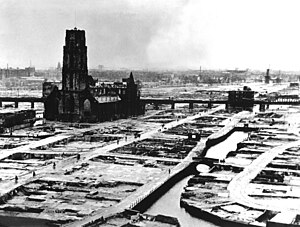

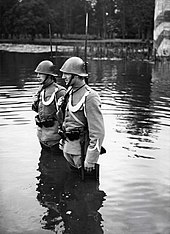




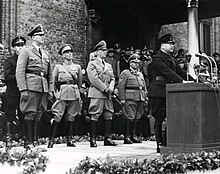

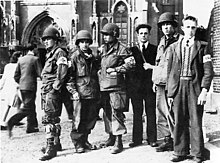


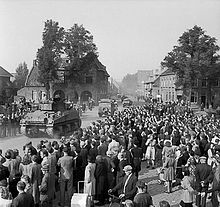

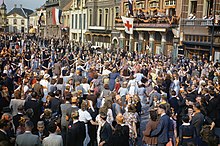

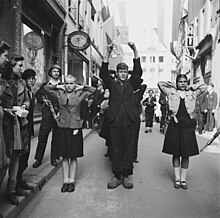

Timeline of the Netherlands during World War IIRotterdamGerman bombingGerman invasion of the NetherlandsDutch neutralityNazi GermanyinvadedNetherlandsFall Gelbbombing of RotterdamDutch governmentroyal familyLondonGerman surrenderActive resistancemajority of the country's JewsNazi concentration campsBelgiumFranceAmsterdamFebruary strikeWorld War IIArthur Seyss-Inquartliving standardsAlliesHunger WinterGerman surrender at Lüneburg HeathPeel-Raam LineDutch East IndiesFirst World WarNetherlands were hitGreat DepressionHendrikus Colijnguildergold standardItalian fascismNazismNational Socialist Movement in the NetherlandsNational Socialist German Workers' PartySecond World WarZuiderzee WorksWieringermeerAfsluitdijkDuring World War IPieter Cort van der LindenAnti-Revolutionary Partynational spendingGrebbePeel-Raam LinesDordrechtUtrechtHaarlemBritish EmpireBattle of the NetherlandsLuxembourgArdennesNorth HollandLuftwaffeNorth Seaarmed forces of the NetherlandsRoyal Netherlands ArmytankettesbiplanesWehrmachtparachute assault on the first dayThe HagueOckenburgYpenburgtransport aircraftplanned invasion of Britaincrossing the Maas riverFort Ében-Émaelpushing the Dutch backGrebbe Lineon the narrow Afsluitdijk CausewayGerman advance into BelgiumBattle of RotterdamRotterdam BlitzseaplanesHenri WinkelmanZeelandMiddelburgDutch EmpireRoyal Dutch NavyQueen Wilhelminagovernment-in-exileCanadaRation stampsReichskommissariat NiederlandeGleichschaltungpillarisationCatholic Church in the NetherlandsRoman CatholicsNazifiedGreater Germanic ReichAdolf HitlerAryan "master race"Battle of BritainOperation Barbarossain the Eastern Front of World War IIHongerwinterNero DecreeDeelen Air BaseArnhemRuhrgebietArbeitseinsatzrationingAtlantic WallDenmarkNorwayScheveningenpassive resistanceThe Holocaust in the NetherlandsHistory of the Jews in the NetherlandsAnne FrankMauthausen-Gusen concentration campJewish CouncilDavid CohenAbraham AsscherCommittee for Jewish RefugeesWesterbork transit campStar of David badgesTitus BrandsmaAmersfoortmixed marriageAd van Liempt